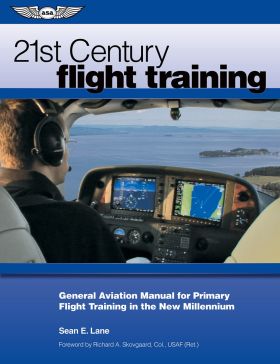21st Century Flight Training
A powerful resource for flight instructors and their students, with insights into the challenges of training in the new millennium.
Effective flight training in this advanced technological age calls for improved teaching methods. Sean Lane’s 21st Century Flight Training discusses core concepts such as flight phases, task prioritization, proficiency segments for performance maneuvers, as well as visual situational awareness—all of which lead to improved training efficiency and intelligent aeronautical decision making.
The book introduces new training models such as Integrated Sensory Flying (ISF): a concept that answers a long-awaited call for a visual flight instruction program similar to that of Basic Attitude Instruments (BAI). The new training models and teaching methods provide tools to help resolve the inherent conflict between technically advanced aircraft and an increasingly complex flight environment, and general aviation accident trends.
21st Century Flight Training teaches all the primary flight training maneuvers from the perspective of an examiner with countless checkride insights, guiding readers from initial flight instructor lessons to conducting flight reviews on their own. Flight instructor candidates are led through the development of a complete set of lesson plans, learning how to teach maneuvers, navigate oral exams and practical tests, and on to operating as twenty-first century flight instructors.
- Applying reasoning and problem solving to achieve intelligent ADM (aeronautical decision making)
- Understanding the mental airplane at work
- Human factors at work in GA
- Integrated Sensory Flying (ISF)—a visual pilot's companion to BAI (basic attitude instrument) flying
- Using visualization to triple flight lesson redundancy and achieve cost efficiencies
- Ingredients of instructional knowledge explained
- Reference Integrations—correlated technical references to increase depth of knowledge
- Progress Points—to improve ground reference maneuver situational awareness, accuracy, and collision avoidance
- Proficiency Segments—to eliminate wasted flight time and to improve performance maneuver learning efficiency
- NTSB Aviation Investigation Manual guidelines converted to accident prevention
No reviews found

